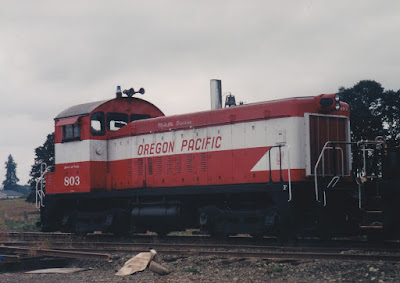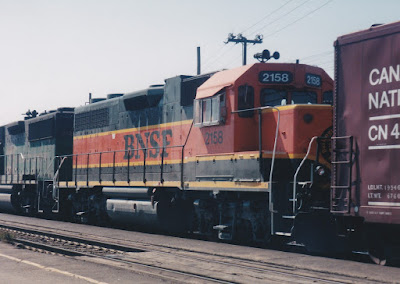Tuesday, August 21, 2018
Inaugural Run of the Amtrak Cascades
On January 11, 1999, Amtrak inaugurated the Cascades service between Seattle, Washington, and Portland, Oregon, using brand-new equipment designed specifically for the route. I went to Kelso, Washington, to photograph the first train.
I believe the southbound train was operating as Train #751, with an arrival time in Kelso around 10:00 in the morning.
The train was pulled by Amtrak locomotive #467, a 3,200-horsepower F59PHI that was built in 1998 by the Electro-Motive Division of General Motors with final assembly by Super Steel Schenectady, Inc., of Schenectady, Pennsylvania. Amtrak purchased 21 of these locomotives, which were numbered from 450 to 470. Locomotives 466 to 470 were delivered in the green, brown and white Cascades color scheme, while the rest were delivered in silver and purple for Surfliner service in California. Aside from the colors, the two paint schemes are otherwise almost identical,
Here is the new Amtrak Cascades logo on one of the Talgo passenger cars. This logo was originally only used on the train cars and not on the locomotives.
At each stop along the route, there was a brief ceremony to commemorate the inauguration of the new train service.
The Amtrak conductor displayed a plaque that commemorated the occasion.
To smooth the transition between the tall locomotive and the low-slung Talgo train, the baggage car and the power car at each end of each train were fitted with tail fins.
There were originally four 12-car Talgo Pendular Series VI trainsets built for Cascades service, named Mt. Hood, Mt. Baker, Mt. Rainier, and Mt. Olympus. This is the Mt. Hood trainset. Each trainset consisted of a baggage car, five coaches, an accessible coach, a bistro car, a dining car, an accessible custom class car, a custom class car, and a power car.
At the end of the train, there was no locomotive or power car for the tailfins to meet up with. Note the red marker lights mounted near the top of the tailfins. The appearance of the tailfins at the end of the train led to comparisons with late 1950s automobiles, as well as the Batmobile.
Sunday, August 19, 2018
Trains in Liberal, Oregon, in September, 1998
On our way to visit the Pacific Northwest Live Steamers' Shady Dell Train Park in Molalla, Oregon, in September 1998, my dad and I stopped in nearby Liberal, Oregon, to photograph some locomotives on the Molalla Division of Dick Samuels' Oregon Pacific Railroad. My dad's pictures came out underexposed, but I am including them anyway.
Locomotive #602 is an 800-horsepower SW8, built by the Electro-Motive Division of General Motors in July 1952 as Bamberger Railroad #602. After the Bamberger shut down it was sold to the Yreka Western in 1958. It was transferred in 1978 to the Oregon Pacific & Eastern, which was under the same ownership as the Yreka Western.
 |
| Photo by Cliff West |
Locomotive #803, "Spirit of Canby," is an SW8 built by EMD in March 1953 as Texas & New Orleans (a Southern Pacific subsidiary) #13. In the systemwide renumbering of 1965, it became Southern Pacific #1105.
 |
| Photo by Cliff West |
 |
| Photo by Cliff West |
 |
| Photo by Cliff West |
Here is a view of the two locomotives together, with the RSG Forest Products mill in the background.
Railfanning in Vancouver, Washington, in August 1998
I took these pictures while railfanning at the Amtrak depot in Vancouver, Washington, in late April of 1998. First is a southbound freight train, led by Burlington Northern 3125, a 3,500-horsepower GP50 that was built by the Electro-Motive Division of General Motors in July 1985.
The second locomotive in this consist, Electro-Motive Leasing #789 is a 2,000-horsepower GP38-2 that was built by the Electro-Motive Division of General Motors in June 1972 as Penn Central #7989 and became Conrail #7989 in 1976. Originally financed under a lease arrangement, Conrail #7940-8039 were returned to EMD at the end of the lease period in 1987 and became part of the Electro-Motive Leasing fleet as EMDX #740-839, with their Conrail markings painted out and EMD logos applied. Many of these units were leased to Burlington Northern and Burlington Northern Santa Fe over the years, where they were referred to as GP38Es.
The trailing locomotive, Burlington Northern Santa Fe #2158 is a 2,000-horsepower GP38 that was built by the Electro-Motive Division of General Motors in May 1970 as Penn Central #7829 and became Conrail #7829 in 1976. Burlington Northern purchased it from Conrail in July 1985, and it became Burlington Northern #2158, and was reclassified as a GP38X. It kept its number through the Burlington Northern Santa Fe merger of 1995.
This train paused in front of the Vancouver depot, giving me an opportunity for more photographs of BNSF #2158. This was only the second former Burlington Northern locomotive I had seen that had been repainted in BNSF's orange and green colors. In addition to being repainted, it had also had its headlight relocated from above the cab to the nose, following Santa Fe practice.
Unlike BNSF's new orange and green Dash 9-44CWs and previously repainted GP38-2 #2099, which had silver fuel tanks and trucks, this unit fuel tank and trucks were painted green. This would be the standard for all future repaints as well.
In the Vancouver yard were a pair of Burlington Northern switchers with a crane. Starting on the right, Burlington Northern #428 is a 1,000-horsepower SW1000 that was built by the Electro-Motive Division of General Motors in January 1971. Burlington Northern classified it as an SW10.
I believe the crane is Burlington Northern D-200, a 200-Ton Crane that was built by Industrial Works in Bay City, Michigan in 1927 as Great Northern X1745. It was one of the last pieces of equipment built by Industrial before merging with Brown Hoisting Machinery Company of Cleveland, Ohio, to form Industrial Brownhoist Corporation on September 26, 1927. Originally steam-powered, it was later converted to diesel power. Initially assigned Burlington Northern #972013 on June 9, 1972, it was renumbered to Burlington Northern D-200 on July 10, 1972. It was initially retired in October 1987, but was reinstated in June 1988 and remained in service for at least another decade, as seen here.
Finally, Burlington Northern Santa Fe #3603 is a 1,000-horsepower SW1000 that was originally built by the Electro-Motive Division of General Motors in February 1972 as Burlington Northern #378. Burlington Northern and Burlington Northern Santa Fe classified it as an SW10.
Wednesday, August 15, 2018
Astoria Line Excursion in August 1998
On the weekend of August 22nd and 23rd of 1998, the Pacific Railroad Preservation Association's Spokane, Portland & Seattle E-1 Class 4-8-4 #700 was scheduled to pull a series of excursion trains on the Portland & Western Railroad's Astoria Line from Linnton to Saint Helens and back. My dad and I heard about the excursions and went to photograph one of the trips on Sunday the 23rd. When we got to Linnton, we learned that before the first excursion departed on Saturday, the steam locomotive broke down (it turned out to be a bent radius rod), requiring the excursion trains to be pulled by diesel locomotives while the steam locomotive remained in Linnton under a blue tarp.
The other diesel locomotive was Willamette & Pacific #2317, Tigard, a 2,300-horsepower GP39-2 that was built by the Electro-Motive Division of General Motors in 1974 as Atchison, Topeka & Santa Fe #3616. It is one of a group of 17 GP39-2s Willamette & Pacific acquired from the Santa Fe in 1993.
Even though the excursion train was pulled by diesels instead of the steam locomotive, we chased it for part of its westbound trip anyway. Here is the train pictured along NW Marina Way in Linnton, shortly after departure.
Here is the excursion train at Holbrook, Oregon. The train was traveling very slowly, making it easy to get ahead of it on the parallel U.S. Highway 30.
Here is a picture of the excursion train from a point along Highway 30.
Finally, here is the excursion train approaching Lower Rocky Point Road near Scappoose, Oregon. After this, we gave up on the chase and headed home.
One of the locomotives that was drafted into service was Portland & Western SD9R #1851, Hillsboro. It was originally built by the Electro-Motive Division of General Motors in April 1954 as Southern Pacific #5360. In 1965 it was renumbered to #3819. On January 11, 1971, it was upgraded at Southern Pacific's Sacramento General Shops as SD9R #4326. It was retired by Southern Pacific on February 12, 1993, and was sold to the Willamette & Pacific on April 4, 1994, where it became #1851. It was transferred to the Portland & Western in May 1995.
The other diesel locomotive was Willamette & Pacific #2317, Tigard, a 2,300-horsepower GP39-2 that was built by the Electro-Motive Division of General Motors in 1974 as Atchison, Topeka & Santa Fe #3616. It is one of a group of 17 GP39-2s Willamette & Pacific acquired from the Santa Fe in 1993.
Two private passenger cars were parked in Linnton but were not part of the excursion train. One of these was Nicolet Scenic Railroad NBNR 8150 Running Crane Lake, a Lounge-Diner-Coffee Shop Car that was originally built by American Car & Foundry in 1951 as Great Northern Railway #1241 Running Crane Lake for the Empire Builder between Chicago and Seattle. This was one of six such cars, which were referred to as "Ranch" cars on the Great Northern, and featured Western-themed interiors. The car retained its GN number when the Great Northern was merged into the Burlington Northern on March 2, 1970. After the creation of Amtrak on May 1, 1971, the car became Amtrak #8150 in 1972. After being retired by Amtrak, the car ended up on the Nicolet Badger Northern Railroad in Wisconsin, and was used in an excursion service called the Nicolet Scenic Railroad. The Nicolet Badger Northern Railroad shut down in 1994, and this car was acquired by a private owner.
The other private car parked in Linnton was Business Car Casper Mountain, which was originally built by Pullman in 1924 as Atchison, Topeka & Santa Fe Business Car #35. It was originally assigned to the Assistant General Manager of the Eastern Lines. It was reassigned to the General Manager of the Gulf Lines in 1966. It was renumbered to #57 in 1973. It was retired in 1980 and sold to a private owner. It was restored to its original number#35 and named Louisa. It was sold again and renamed Casper Mountain. It carries the road name Wyoming & Pacific on the letterboard, but this railroad does not exist; it is merely a reference to the owner's home state. Its official reporting mark and number is PPCX #800182.
Even though the excursion train was pulled by diesels instead of the steam locomotive, we chased it for part of its westbound trip anyway. Here is the train pictured along NW Marina Way in Linnton, shortly after departure.
Here is the excursion train at Holbrook, Oregon. The train was traveling very slowly, making it easy to get ahead of it on the parallel U.S. Highway 30.
Here is a picture of the excursion train from a point along Highway 30.
Finally, here is the excursion train approaching Lower Rocky Point Road near Scappoose, Oregon. After this, we gave up on the chase and headed home.
Labels:
Diesel Locomotive,
EMD,
Excursion,
GP39-2,
Linnton,
Oregon,
Passenger Car,
Passenger Train,
Portland & Western Railroad,
Scappoose,
SD9,
SD9R,
Willamette & Pacific Railroad
Subscribe to:
Posts (Atom)


























